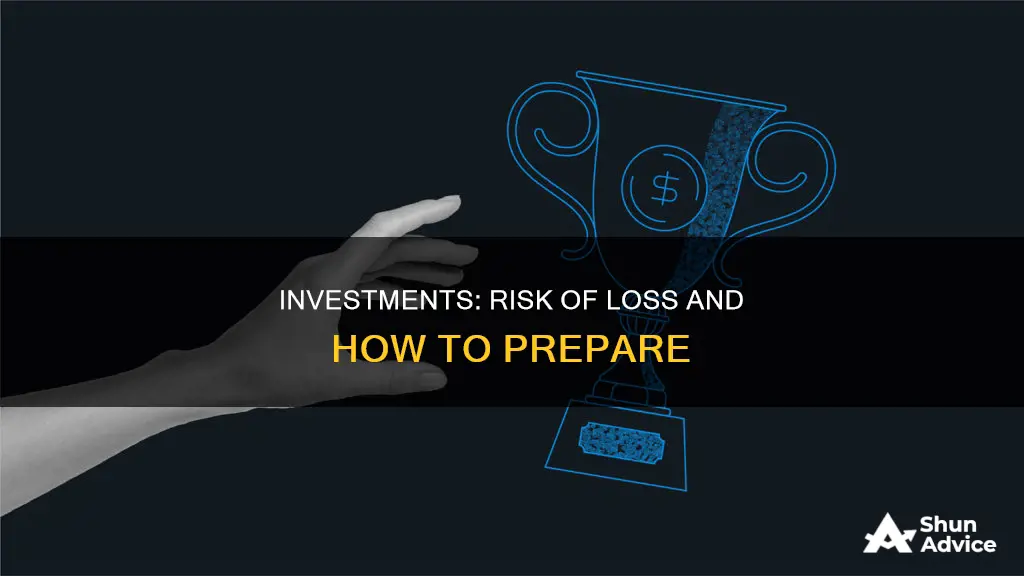
Investing is a risky business. All investments carry some degree of risk, and there is always a possibility of losing some or all of your original investment. This is true even for the most conservative, insured investments, such as certificates of deposit (CDs) issued by banks or credit unions, which are vulnerable to inflation risk. The level of risk associated with an investment typically correlates with the level of return that investment might achieve. In other words, the higher the risk, the higher the potential reward.
There are several types of risk to be aware of when investing. Market risk refers to the possibility of losing investments due to factors that affect the performance of the overall market, such as political or macroeconomic events. Business risk refers to the basic viability of a business, and whether it will be able to generate enough revenue to cover its operational expenses and turn a profit. There's also liquidity risk, which refers to how easy or hard it is to cash out of an investment, and concentration risk, which refers to putting too many financial eggs in one basket.
While it's not possible to eliminate investment risk entirely, there are strategies that can help to manage it. Diversification, for example, is a common strategy that involves spreading your investments across different vehicles, industries, sectors, and regions. This helps to reduce the impact of unsystematic risk, or risk that is specific to individual companies or industries. Another strategy is hedging, which involves buying a security to offset a potential loss on another investment.
| Characteristics | Values |
|---|---|
| Possibility of Loss | All investments carry some degree of risk and the possibility of loss. |
| Risk Factors | Market conditions, corporate decisions, international events, liquidity, concentration, time horizon, inflation, interest rates, political instability, credit risk, default risk, country risk, foreign exchange rates, operational risk, legal risk, etc. |
| Risk Mitigation | Diversification, hedging, asset allocation, understanding investor psychology, regular risk assessment, dollar cost averaging, etc. |
| Risk-Reward | Higher risk investments have the potential for higher returns but no guarantees. |
| Risk Tolerance | Determined by an investor's comfort level, financial situation, age, income, investment goals, liquidity needs, personality, etc. |
What You'll Learn

Risk and return
The relationship between risk and return is crucial. Generally, the greater the amount of risk an investor is willing to take, the greater the potential return they expect. This relationship is based on the rationale that investors taking on risky investments and potentially losing money should be rewarded for their risk. As a result, investments with higher risk tend to offer the possibility of higher returns. For instance, stocks have historically provided higher average annual returns than bonds or cash investments, but with a higher level of risk.
It's important to note that while higher-risk investments have the possibility of higher returns, there are no guarantees. The risk-return trade-off indicates that higher-risk investments may offer higher returns, but it does not ensure they will. Additionally, the time horizon is a key factor in risk and return. Younger investors with longer time horizons until retirement may be more inclined to invest in higher-risk investments, as they have more time to recoup any potential losses. Conversely, older investors with shorter time horizons tend to have a lower risk tolerance and seek more immediate access to their funds.
To manage risk and optimise returns, investors can employ strategies such as asset allocation, diversification, and hedging. Diversification, in particular, is a widely recommended strategy, involving the distribution of investments across various asset types, industries, and risk levels. This approach helps to balance risk and return, providing the potential for improved returns while minimising losses.
Lastly, it's worth mentioning that understanding one's risk tolerance and capacity is essential. Risk tolerance refers to an investor's comfort level with taking on risk, while risk capacity pertains to their financial ability to take on risk based on their current financial situation. By assessing their risk tolerance and capacity, investors can make more informed decisions about the level of risk they are willing and able to accept in pursuit of their desired returns.
Wait Until Valentine's Day to Make Your Next Investment Move
You may want to see also

Risk tolerance
There are two main aspects to consider when determining your risk tolerance: your willingness to take risks and your financial ability to do so.
Willingness to Take Risks
This is a subjective measure and tends to remain constant regardless of your financial position. Everyone has a different comfort level with risk, and this will influence the types of investments you make. For example, some investors may be comfortable with a stocks-only portfolio, while others may prefer to avoid volatile stocks in favour of low-risk bonds and cash.
Financial Ability to Take Risks
Unlike willingness, your financial ability to take risks is based on an objective assessment of your financial circumstances. This includes factors such as your liquidity needs, time horizon, and the importance of the investment goal to your financial well-being. For instance, if you are funding long-term care or saving for your children's education, you may want to take a more conservative approach to lower the risk of not achieving your goals.
Factors Affecting Risk Tolerance
To help determine your risk tolerance, you can ask yourself several questions:
- What are your investment goals? Understanding why you are investing is the first step towards knowing how much risk you are willing to take.
- What is your time horizon? Generally, a longer time horizon allows for more risk-taking as there is more time for investments to recover from potential downturns.
- How comfortable are you with short-term losses? It's important to remember that with volatile investments like stocks, you only realise the loss when you sell. A longer time frame can help you ride out short-term fluctuations.
- Do you have non-invested savings? It is advisable to have some savings set aside in liquid accounts to cover emergencies. If a large portion of your savings is in cash, it may indicate risk aversion.
- How often will you track your investments? If you plan to closely follow the performance of your investments, ask yourself if it is due to nervousness or excitement about new opportunities.
By considering these factors and understanding your risk tolerance, you can make more informed investment decisions that align with your financial goals and comfort level.
Understanding Your Financial Investment Portfolio Better
You may want to see also

Systematic and unsystematic risk
All investments carry some degree of risk. Even the most conservative investments, such as cash, can be subject to loss. For instance, cash can be stolen, misplaced, or destroyed.
When it comes to investing, risk is any uncertainty that may negatively impact your financial welfare. There are two types of risk: systematic and unsystematic.
Systematic Risk
Systematic risk, also known as market risk, is the uncertainty that affects many investments. It is typically caused by macroeconomic factors beyond the control of businesses or investors, such as inflation, exchange rates, political instability, and natural disasters. Systematic risk is inherent in the market and cannot be diversified away. It affects the financial market as a whole and is non-diversifiable.
Unsystematic Risk
Unsystematic risk, on the other hand, is specific to an individual investment or industry sector. It is also known as nonsystematic risk, specific risk, or residual risk. Unsystematic risk arises from internal and external factors that affect a particular organization or industry but not the entire market. Examples include labour unrest, regulatory changes, and shortages of raw materials.
Unsystematic risk can be controlled, minimized, or possibly avoided through diversification strategies. By investing in a variety of assets and industries, investors can reduce their exposure to unsystematic risk.
Managing Risk
While it is impossible to eliminate investment risk, there are strategies to manage it, such as asset allocation and diversification. Hedging and insurance products can also provide additional ways to manage risk, although they typically add to the cost of investment.
Investment Savings: Average Amounts in the United States
You may want to see also

Risk management strategies
All investments carry some degree of risk. Even the most conservative investments, such as cash, can be stolen, misplaced, or destroyed. Therefore, investors should adopt risk management strategies to mitigate potential losses.
Asset Allocation
Asset allocation involves investing in different asset classes, such as stocks, bonds, alternative investments, and cash. It is essential to consider your financial goals, risk tolerance, tax situation, and time horizon when deciding on an allocation strategy. For example, an investor with a high-risk tolerance and a long time horizon may allocate 80% of their portfolio to stocks and 20% to bonds.
Portfolio Diversification
Portfolio diversification involves selecting a variety of investments within each asset class. This strategy helps to reduce the impact of major market swings on your portfolio. By investing in multiple companies across different industries, you can reduce the potential for substantial losses.
Dollar-Cost Averaging
Dollar-cost averaging is a strategy where you invest a fixed amount of money into the same investment vehicle(s) at regular intervals, regardless of market performance. This approach helps to build wealth gradually by diversifying the prices at which you buy shares. It also helps to avoid emotional investment decisions, as it is a systematic approach.
Hedging and Insurance Products
Hedging involves buying a security to offset potential losses on another investment. For example, you can hedge your portfolio by purchasing a put option on a specific company or commodity, such as crude oil. Insurance products can also provide additional protection against potential losses. However, these strategies typically add significant costs to your investment.
Understanding Risk Tolerance
Knowing your risk tolerance level is crucial when making investment decisions. Your risk tolerance refers to the amount of potential investment loss you are willing and able to accept. It is essential to consider both your comfort level with risk and your financial risk capacity, which is influenced by factors such as your age, income, and financial obligations.
Understanding Investment Portfolio Beta: A Beginner's Guide
You may want to see also

Riskless investments
While all investments carry some degree of risk, there are a few options that are considered to be relatively risk-free. Here are some examples of investments that are generally regarded as being among the safest available:
High-Yield Savings Accounts
High-yield savings accounts are offered by many online banks, credit unions, and traditional banks. These accounts provide a modest return on your money and are completely safe in the sense that you will not lose the principal amount. Most accounts are government-insured for up to $250,000 per account type per bank, ensuring that you will be compensated even if the financial institution fails. However, it is important to note that inflation can erode the purchasing power of the money in these accounts over time.
Money Market Funds
Money market funds are mutual funds that invest in short-term, low-risk assets like Treasury and government securities, commercial paper, or municipal debt. They are typically sold by brokerage firms and mutual fund companies. These funds offer diversification and liquidity, and the income you receive will fluctuate based on the yields available on the underlying securities. While money market funds are considered safe, they are not protected by the FDIC or NCUA, so there is a small degree of risk involved.
Short-Term Certificates of Deposit (CDs)
Bank CDs are considered loss-proof as long as they are held in an FDIC-backed account and the money is not withdrawn early. Short-term CDs offer better liquidity than longer-term options, and rates remain attractive even when the Federal Reserve lowers interest rates. By investing in a CD, you are promised a set rate of interest over a specified term, providing a safe and reliable return. However, withdrawing funds early will typically result in a penalty, and locking your money into a CD for an extended period may cause you to miss out on more lucrative investment opportunities if interest rates rise.
US Treasury Securities
Treasury securities are backed by the US government and come in three main types: bills, notes, and bonds. Bills mature in one year or less, notes span up to 10 years, and bonds typically mature in 20 to 30 years. Investing in Treasury securities provides regular interest payments and the return of your principal at maturity. The government also offers Treasury Inflation-Protected Securities (TIPS), which have a fixed interest rate but adjust the principal value based on inflation or deflation. While TIPS can help hedge against inflation, their interest rates are often lower than other Treasury securities.
Corporate Bonds
Corporate bonds represent debt issued by companies to finance their growth and are suitable for investors seeking relatively low-risk investments with steady income. Well-established companies tend to offer safer bonds, while those from less creditworthy firms may carry higher yields but also higher default risk. Corporate bonds can generate higher yields compared to government bonds, but this comes with additional credit and interest rate risks.
It is important to remember that while these investment options are considered relatively safe, they may still carry some degree of risk. Additionally, the trade-off for lower risk is often lower returns over the long run. These investment options are suitable for those looking to preserve capital and maintain a steady flow of interest income rather than seeking high growth.
Equity Investors: Share Owners or Not?
You may want to see also
Frequently asked questions
Yes, all investments carry some degree of risk. Even the safest investments, such as government bonds or risk-free securities, carry a minimal level of risk. The possibility of loss is always present, but the level of risk varies depending on the type of investment.
The level of risk associated with an investment depends on various factors, including the type of investment, market conditions, diversification, time horizon, and individual investor characteristics. Different types of investments, such as stocks, bonds, or mutual funds, have different inherent risks. Market conditions, such as political instability or interest rate changes, can also impact the risk of loss.
Diversification is a risk management strategy that involves spreading investments across different assets, industries, or sectors. By diversifying your portfolio, you can reduce the impact of specific risks associated with individual investments and lower the overall risk of loss.
The time horizon, or the amount of time you plan to hold an investment, is a crucial factor in determining the risk. Generally, longer time horizons allow for greater risk-taking as there is more time to recover from potential losses. Shorter time horizons typically require more conservative investment strategies to minimise the risk of loss.
An investor's profile, including their risk tolerance, risk capacity, financial situation, and investment goals, is essential for assessing the risk of loss. Risk tolerance refers to an investor's comfort level with risk, while risk capacity is the amount of financial risk they can take based on their financial situation. Understanding these factors helps determine the appropriate level of risk for an individual's investment portfolio.







